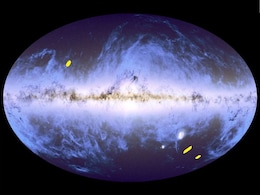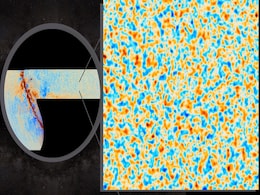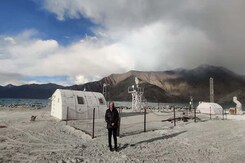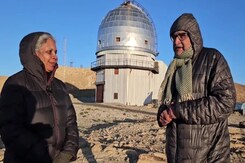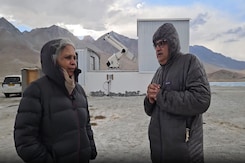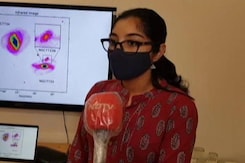Astrophysics
- All
- News
- Videos
-

Watch: Missing Half Of Universe's Visible Matter Found Hiding In Intergalactic Space
- Friday April 18, 2025
- Science | Edited by Nikhil Pandey
Scientists have located the missing half of the Universe's visible matter as vast clouds of ionized hydrogen in intergalactic space, confirming it through novel techniques and survey programs showing the material is further from galactic cores than p
-
 www.ndtv.com
www.ndtv.com
-

JWST Captures Unseen Details of Exoplanets in HR 8799 and 51 Eridani Systems
- Thursday April 3, 2025
- Written by Gadgets 360 Staff
The James Webb Space Telescope (JWST) has captured groundbreaking images of exoplanets in the HR 8799 and 51 Eridani systems. By modifying its coronagraphs, astronomers allowed more starlight to pass through, revealing clearer planetary details. The study, published in The Astrophysical Journal Letters, highlights the first successful detection of ...
-
 www.gadgets360.com
www.gadgets360.com
-

Laboratory Test Shows Ion-Molecule Collision Theory Fails to Produce Benzene in Space Conditions
- Thursday April 3, 2025
- Written by Gadgets 360 Staff
A recent laboratory experiment conducted by researchers at JILA and NIST has disproved a long-held theory about how benzene forms in interstellar space. The study tested ion-molecule collisions at near-zero temperatures and extremely low pressure but failed to produce benzene. This challenges earlier theories linking benzene to the formation of car...
-
 www.gadgets360.com
www.gadgets360.com
-

Did Black Hole Radiation Shape the Universe?
- Saturday March 29, 2025
- Written by Gadgets 360 Staff
A study suggests that Hawking radiation, first proposed by Stephen Hawking, may have influenced the universe’s structure. According to reports, primordial black holes that existed in the early universe could have evaporated through Hawking radiation, impacting matter distribution. The research explores how these black holes might have shaped gala...
-
 www.gadgets360.com
www.gadgets360.com
-

ESA’s Euclid Telescope Releases First Data, Mapping 26 Million Galaxies
- Wednesday March 26, 2025
- Written by Gadgets 360 Staff
ESA’s Euclid telescope has released its first dataset, mapping 26 million galaxies within a week. The observations include deep-field images, a survey of 380,000 galaxies, and 500 new gravitational lens candidates. Scientists will continue tracking cosmic evolution over six years. The dataset, currently 35 terabytes, is expected to grow to 2 peta...
-
 www.gadgets360.com
www.gadgets360.com
-

Atacama Telescope Reveals Most Detailed Cosmic Microwave Background Yet
- Thursday March 20, 2025
- Written by Gadgets 360 Staff
New images from the decommissioned Atacama Cosmology Telescope offer the most detailed view of the cosmic microwave background. The data reveals early cosmic structures, tracks primordial gas movement, and refines estimates of the universe’s total mass. While supporting existing models, it does not resolve the Hubble tension. Researchers are now ...
-
 www.gadgets360.com
www.gadgets360.com
-

Water May Have Formed in the Universe 100 Million Years After Big Bang
- Thursday March 13, 2025
- Written by Gadgets 360 Staff
A new study suggests water formed in the universe just 100–200 million years after the Big Bang, much earlier than previously estimated. Researchers examined ancient supernovas to understand how oxygen combined with hydrogen to create water. If confirmed, these findings could change perspectives on when the conditions for life first emerged. The ...
-
 www.gadgets360.com
www.gadgets360.com
-

New Dark Matter Hypothesis Suggests Ionisation Clue in Milky Way’s Core
- Wednesday March 12, 2025
- Written by Gadgets 360 Staff
Researchers propose that an overlooked dark matter candidate may explain unusual ionisation levels in the Milky Way’s Central Molecular Zone (CMZ). This theory suggests that lightweight, self-annihilating dark matter particles could be producing electrons and positrons, influencing cosmic chemistry. The findings challenge conventional views, offe...
-
 www.gadgets360.com
www.gadgets360.com
-

Supermassive Black Hole May Be Hiding in Large Magellanic Cloud, Scientists Suggest
- Monday March 10, 2025
- Written by Gadgets 360 Staff
A potential supermassive black hole may exist in the Large Magellanic Cloud, as per recent scientific findings. Researchers analysed hypervelocity stars moving at extreme speeds and found many could have been ejected from this neighbouring galaxy. The black hole is estimated to be around 600,000 times the mass of the Sun. If confirmed, this discove...
-
 www.gadgets360.com
www.gadgets360.com
-

Harvard Scientist Claims God Is Real, Reveals Mathematical Formula To Prove It
- Friday March 7, 2025
- Feature | Edited by Bhavya Sukheja
Dr Willie Soon, an astrophysicist and aerospace engineer, who has worked for a long time at the Harvard and Smithsonian Centre for Astrophysics, has recently claimed that a mathematical formula could be the ultimate proof of God's existence.
-
 www.ndtv.com
www.ndtv.com
-

Black Hole Singularities May Not Exist, Say Scientists
- Friday March 7, 2025
- Written by Gadgets 360 Staff
A new study questions the existence of black hole singularities, suggesting refinements to Einstein’s equations using quantum gravity concepts. Researchers argue that infinite density points may not be real, replacing them with highly curved but finite regions of space-time. While direct observation remains difficult, gravitational waves and earl...
-
 www.gadgets360.com
www.gadgets360.com
-

Aditya-L1’s SUIT Telescope Captures First-Ever Solar Flare Kernel, Revealing Unseen Solar Activity
- Friday March 7, 2025
- Written by Gadgets 360 Staff
India’s Aditya-L1 mission has achieved a historic milestone with its Solar Ultra-violet Imaging Telescope (SUIT) capturing the first-ever solar flare kernel in the near-ultraviolet spectrum. This unprecedented observation confirms energy transfer across different layers of the Sun's atmosphere, advancing the understanding of solar flares and spac...
-
 www.gadgets360.com
www.gadgets360.com
-

New Study Reveals How Pulsars Help Measure Dark Matter in the Milky Way
- Tuesday March 4, 2025
- Written by Gadgets 360 Staff
A breakthrough study has used pulsar acceleration data to measure dark matter density in the Milky Way. Previously, binary pulsars were the primary source of data, but now solitary pulsars have been included, doubling the dataset. The research also provides evidence of the Milky Way’s "wobble" due to interactions with dwarf galaxies. By mapping t...
-
 www.gadgets360.com
www.gadgets360.com
-

Astronomers Discover Largest Collection of Missing Link Black Holes in Dwarf Galaxies
- Thursday February 20, 2025
- Written by Gadgets 360 Staff
Astronomers have uncovered 2,500 dwarf galaxies containing active black holes using DESI data. This marks the largest-ever discovery of intermediate-mass black holes, with 300 new candidates identified. These findings could help scientists understand how black holes evolve from stellar-mass to supermassive sizes. The research, based on 410,000 gala...
-
 www.gadgets360.com
www.gadgets360.com
-

James Webb Space Telescope Captures Sagittarius A Emitting Continuous Flares in Milky Way’s Core
- Thursday February 20, 2025
- Written by Gadgets 360 Staff
The James Webb Space Telescope has captured Sagittarius A*, the Milky Way’s supermassive black hole, emitting flares continuously. These bursts, varying in intensity and duration, have been observed over multiple sessions. Scientists believe the activity may be linked to magnetic interactions within the accretion disk. The phenomenon appears rand...
-
 www.gadgets360.com
www.gadgets360.com
-

Watch: Missing Half Of Universe's Visible Matter Found Hiding In Intergalactic Space
- Friday April 18, 2025
- Science | Edited by Nikhil Pandey
Scientists have located the missing half of the Universe's visible matter as vast clouds of ionized hydrogen in intergalactic space, confirming it through novel techniques and survey programs showing the material is further from galactic cores than p
-
 www.ndtv.com
www.ndtv.com
-

JWST Captures Unseen Details of Exoplanets in HR 8799 and 51 Eridani Systems
- Thursday April 3, 2025
- Written by Gadgets 360 Staff
The James Webb Space Telescope (JWST) has captured groundbreaking images of exoplanets in the HR 8799 and 51 Eridani systems. By modifying its coronagraphs, astronomers allowed more starlight to pass through, revealing clearer planetary details. The study, published in The Astrophysical Journal Letters, highlights the first successful detection of ...
-
 www.gadgets360.com
www.gadgets360.com
-

Laboratory Test Shows Ion-Molecule Collision Theory Fails to Produce Benzene in Space Conditions
- Thursday April 3, 2025
- Written by Gadgets 360 Staff
A recent laboratory experiment conducted by researchers at JILA and NIST has disproved a long-held theory about how benzene forms in interstellar space. The study tested ion-molecule collisions at near-zero temperatures and extremely low pressure but failed to produce benzene. This challenges earlier theories linking benzene to the formation of car...
-
 www.gadgets360.com
www.gadgets360.com
-

Did Black Hole Radiation Shape the Universe?
- Saturday March 29, 2025
- Written by Gadgets 360 Staff
A study suggests that Hawking radiation, first proposed by Stephen Hawking, may have influenced the universe’s structure. According to reports, primordial black holes that existed in the early universe could have evaporated through Hawking radiation, impacting matter distribution. The research explores how these black holes might have shaped gala...
-
 www.gadgets360.com
www.gadgets360.com
-

ESA’s Euclid Telescope Releases First Data, Mapping 26 Million Galaxies
- Wednesday March 26, 2025
- Written by Gadgets 360 Staff
ESA’s Euclid telescope has released its first dataset, mapping 26 million galaxies within a week. The observations include deep-field images, a survey of 380,000 galaxies, and 500 new gravitational lens candidates. Scientists will continue tracking cosmic evolution over six years. The dataset, currently 35 terabytes, is expected to grow to 2 peta...
-
 www.gadgets360.com
www.gadgets360.com
-

Atacama Telescope Reveals Most Detailed Cosmic Microwave Background Yet
- Thursday March 20, 2025
- Written by Gadgets 360 Staff
New images from the decommissioned Atacama Cosmology Telescope offer the most detailed view of the cosmic microwave background. The data reveals early cosmic structures, tracks primordial gas movement, and refines estimates of the universe’s total mass. While supporting existing models, it does not resolve the Hubble tension. Researchers are now ...
-
 www.gadgets360.com
www.gadgets360.com
-

Water May Have Formed in the Universe 100 Million Years After Big Bang
- Thursday March 13, 2025
- Written by Gadgets 360 Staff
A new study suggests water formed in the universe just 100–200 million years after the Big Bang, much earlier than previously estimated. Researchers examined ancient supernovas to understand how oxygen combined with hydrogen to create water. If confirmed, these findings could change perspectives on when the conditions for life first emerged. The ...
-
 www.gadgets360.com
www.gadgets360.com
-

New Dark Matter Hypothesis Suggests Ionisation Clue in Milky Way’s Core
- Wednesday March 12, 2025
- Written by Gadgets 360 Staff
Researchers propose that an overlooked dark matter candidate may explain unusual ionisation levels in the Milky Way’s Central Molecular Zone (CMZ). This theory suggests that lightweight, self-annihilating dark matter particles could be producing electrons and positrons, influencing cosmic chemistry. The findings challenge conventional views, offe...
-
 www.gadgets360.com
www.gadgets360.com
-

Supermassive Black Hole May Be Hiding in Large Magellanic Cloud, Scientists Suggest
- Monday March 10, 2025
- Written by Gadgets 360 Staff
A potential supermassive black hole may exist in the Large Magellanic Cloud, as per recent scientific findings. Researchers analysed hypervelocity stars moving at extreme speeds and found many could have been ejected from this neighbouring galaxy. The black hole is estimated to be around 600,000 times the mass of the Sun. If confirmed, this discove...
-
 www.gadgets360.com
www.gadgets360.com
-

Harvard Scientist Claims God Is Real, Reveals Mathematical Formula To Prove It
- Friday March 7, 2025
- Feature | Edited by Bhavya Sukheja
Dr Willie Soon, an astrophysicist and aerospace engineer, who has worked for a long time at the Harvard and Smithsonian Centre for Astrophysics, has recently claimed that a mathematical formula could be the ultimate proof of God's existence.
-
 www.ndtv.com
www.ndtv.com
-

Black Hole Singularities May Not Exist, Say Scientists
- Friday March 7, 2025
- Written by Gadgets 360 Staff
A new study questions the existence of black hole singularities, suggesting refinements to Einstein’s equations using quantum gravity concepts. Researchers argue that infinite density points may not be real, replacing them with highly curved but finite regions of space-time. While direct observation remains difficult, gravitational waves and earl...
-
 www.gadgets360.com
www.gadgets360.com
-

Aditya-L1’s SUIT Telescope Captures First-Ever Solar Flare Kernel, Revealing Unseen Solar Activity
- Friday March 7, 2025
- Written by Gadgets 360 Staff
India’s Aditya-L1 mission has achieved a historic milestone with its Solar Ultra-violet Imaging Telescope (SUIT) capturing the first-ever solar flare kernel in the near-ultraviolet spectrum. This unprecedented observation confirms energy transfer across different layers of the Sun's atmosphere, advancing the understanding of solar flares and spac...
-
 www.gadgets360.com
www.gadgets360.com
-

New Study Reveals How Pulsars Help Measure Dark Matter in the Milky Way
- Tuesday March 4, 2025
- Written by Gadgets 360 Staff
A breakthrough study has used pulsar acceleration data to measure dark matter density in the Milky Way. Previously, binary pulsars were the primary source of data, but now solitary pulsars have been included, doubling the dataset. The research also provides evidence of the Milky Way’s "wobble" due to interactions with dwarf galaxies. By mapping t...
-
 www.gadgets360.com
www.gadgets360.com
-

Astronomers Discover Largest Collection of Missing Link Black Holes in Dwarf Galaxies
- Thursday February 20, 2025
- Written by Gadgets 360 Staff
Astronomers have uncovered 2,500 dwarf galaxies containing active black holes using DESI data. This marks the largest-ever discovery of intermediate-mass black holes, with 300 new candidates identified. These findings could help scientists understand how black holes evolve from stellar-mass to supermassive sizes. The research, based on 410,000 gala...
-
 www.gadgets360.com
www.gadgets360.com
-

James Webb Space Telescope Captures Sagittarius A Emitting Continuous Flares in Milky Way’s Core
- Thursday February 20, 2025
- Written by Gadgets 360 Staff
The James Webb Space Telescope has captured Sagittarius A*, the Milky Way’s supermassive black hole, emitting flares continuously. These bursts, varying in intensity and duration, have been observed over multiple sessions. Scientists believe the activity may be linked to magnetic interactions within the accretion disk. The phenomenon appears rand...
-
 www.gadgets360.com
www.gadgets360.com





